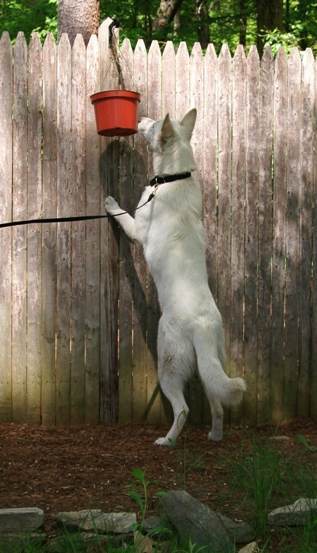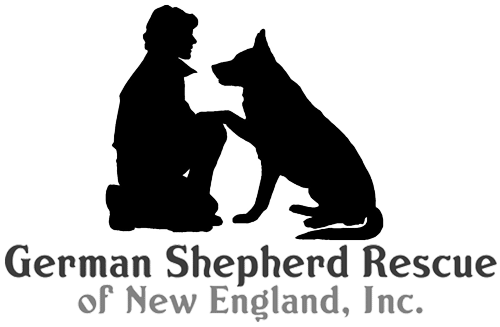There are many reasons for this policy. We regret that some great homes may be passed over because of this policy, but we feel that this policy is best for everybody involved to take the dog and family’s safety into account.
GSRNE places dogs in homes with a fenced yard.

Sassy is safe in her fenced yard
Experience is the best teacher and has taught us that the safest environment for a Rescue German Shepherd includes a fenced yard or area. Generally speaking, most rescued dogs need more limitations because they need time to get to know the new owners and bond. We feel VERY STRONGLY that dogs allowed to wander unsupervised are dogs that are at a greater risk of getting lost, stolen, poisoned or struck by a car. Dogs that run loose are also at risk of exposure to rabid animals, potentially bringing this fatal disease home to the family. GSRNE requires some kind of fenced area attached to your house at the back or side door. This is to ensure the safety of the dog. Your fenced area doesn’t have to be elaborate or expensive. It does NOT have to encompass your entire yard.
The fenced enclosure is intended to guarantee a secure outdoor exercise area for the dog, but is NOT intended as a place for the dog to live. German Shepherds are highly social, people-dogs and need to be with you to be happy.
Placement: Location of the fenced area should also be taken into consideration. It needs to be attached to your house at the back or side door, so it will ensure an increased measure of safety for your dog and prove a convenience for you. It should include a lockable gate. A fence along a sidewalk or road needs to be set back at least 20 feet or be a stockade type fence.
Size: The fenced area needs to be at least 1000 square feet (for example 20’ x 50’) to provide your GSD with a comfortable, safe space in which to get some exercise and fresh air, and to eliminate, without concern of people, kids, animals or wildlife wandering into their area. Kennels or pens do not qualify, unless enclosed within a larger fenced area attached to your house. Shade and shelter from the sun and elements should also be provided as well as fresh water.
Height: We generally require at least a 5′ high fence for active dogs. We are willing to discuss a fence height exception of a 4′ fence for less active dogs.
Type of Fence: A satisfactory fence may be built of stockade, chain link, heavy wooden posts with heavy gauge wire, or metal posts with heavy gage wire, preferably with a rigid metal bar along the top. (No dog should be left unattended for any length of time in the latter type of enclosure because they are relatively easy to escape.) Equal attention should be given to the security of the fence along its bottom in order to prevent dogs from digging out.
Invisible Fencing: Major limitations of the invisible fence system are: an invisible fence does not keep out potential dangers to your dog–any dog or rabid animal may come onto your property, not all dogs can be trained to obey the system, any people coming onto your property do not have the benefit of a physical barrier between themselves and the dog, it does not keep out other dogs. This fencing is not approved because of these potential problems.
Tie-outs: The use of tie-outs or overhead runners is not safe or allowed for a German Shepherd. Dogs on tie-outs may become tangled or choke and are not able to adequately defend themselves from other dogs or animals that may enter the yard. They are easy targets for thieves, are usually not very happy dogs and tend to bark a lot. Tying out German Shepherds has been shown to increase frustration and aggression levels.
Access to the Fenced Area: GSRNE rescue dogs should only be allowed to use the fenced area when supervised, i.e. you are home or outside with the dog. Dog doors allowing your dog access to the outdoors while you are not home are also not considered safe for a rescue GSD. German Shepherds are intelligent, inquisitive dogs who should be with their families, or should be safely inside the house if nobody can supervise them. German Shepherds left outside alone even in a fenced area for long periods of time can develop problems such as digging, barking, and fence frustration at not being able to join people or dogs outside. No dog should be left unattended for any length of time in general, because it is relatively easy for the dog to escape.
Pools: If you have an in-ground pool, you must have a fence around the pool to keep your dog from falling in and drowning. We’re sorry to say that drownings have happened before, even with dogs that have spent years around pools, and we want to prevent it from happening again. Exceptions can be made if 1) your pool has graduated steps and you teach your dog how to get out of the pool using them and 2) you use a pool cover during the winter that can bear the weight of a person.
Senior or Special Needs Dogs: For some senior dogs (8 years and older) the fencing requirement may be waived. This will be approved on a case-by-case basis. We understand there are excellent adopters and dog owners that do not have a fenced yard but the fence requirement will not be waived for younger dogs.
While a secure fence is the goal of our fencing policy, a fence does not automatically make every home a good home for a rescued German Shepherd Dog. A fenced area is just a place for the dog to be off leash and safe, to get some fresh air, eliminate and to play… it is not a place for the dog to live! We regret that this policy may eliminate some homes, but our first concern must be the safety of the dogs with which we have been entrusted. Thank you for your understanding and cooperation.
Note: Dogs cannot be fostered or adopted until your fence has been inspected and all necessary repairs competed.
GSRNE places dogs in the following New England states: Massachusetts, New Hampshire, Maine, Vermont, Rhode Island, and Connecticut. If you live outside our service area, please search other GSD rescue websites for organizations outside of our area.
Thanks to Labrador Retriever Rescue, Inc. for some of the wording.
READ NEXT: If you fit all the above requirements and are interested in adopting, please go to our Adoption Process page.

